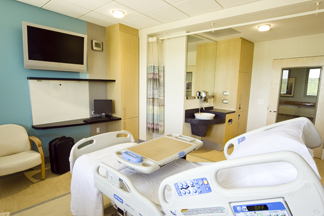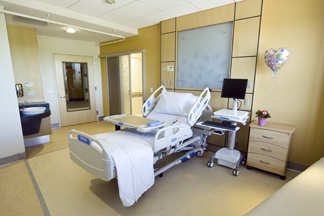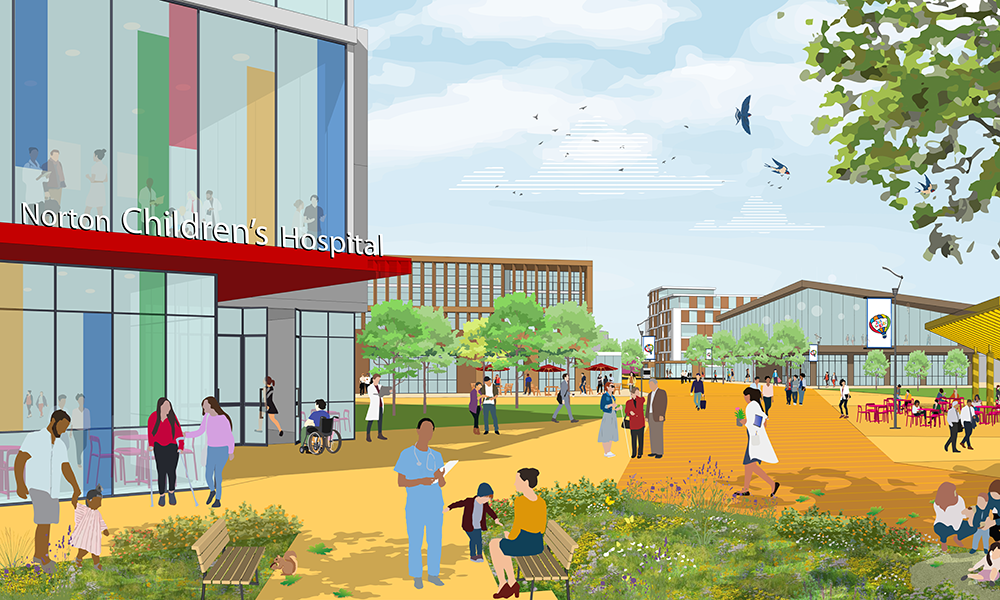
PRINCETON, N.J. — Princeton HealthCare System is testing out an evidence-based-design patient room meant to study how a room’s layout impacts patient slip-and-fall incidents, medication mix-ups, and other hospital-related mishaps.
Once the design is finalized, PHCS will implement it at its new $447 million University Medical Center of Princeton facility that is scheduled to open up in Plainsboro, N.J., in early 2012.
PHCS recently completed work on two mock patient rooms at UMC of Princeton. The rooms’ designs are the result of a year of preliminary research, during which moveable foam core slabs were used to optimally configure walls, the bathroom, the bed and major furnishings.
The testing has already led to the implementation of several key design concepts, according to UCM of P officials. Key design-changes include the implementation of same-handed devices that reduce confusion of the staff. Another key feature is a touch-activated handrail, located between the bed and the bathroom that lights up when gripped.
Funded with a $2.8 million research grant from the Robert Wood Johnson Foundation, the mock patient room initiative will play a key role in the design of the remaining 240 private patient rooms slated for the UMC of Princeton replacement hospital, according to Barry Rabner, President and CEO of the Princeton HealthCare System.
"We went out and toured 15 new hospitals around the country to take advantage of what their staff learned, both the good and the bad, and integrate that research into our plan," Rabner says. "By combining everyone’s best thinking, we ended up with a patient room that was really different from what anybody else had."
"When we started this project, we had several guiding principles that really helped us make our decisions," Rabner added. "For example, we wanted to ensure that the new building design led to reduced errors and infections, improved communications and clinical outcomes, and diminished operating costs."
Notable design improvements include the use of single-patient rooms, which Rabner says will abate the risk of infection and improve communication between caregivers and patients or family members. The new hospital will also allow for the circulation of fresh air to all patient rooms and areas.
Technology upgrades include beds that lower to within several inches from the floor, allowing patients to easily crawl in and out without having as great a risk of injuring themselves. The beds will also have the ability to weigh the patients, reducing the need to travel to or from a scale. Through the use of sensors the nursing staff will be notified if a patient is attempting to get out of bed unsupervised, says Rabner.

Televisions in each room will create another connection between patients and staff, Rabner says. The interactive TVs a method through which patients can order meals, a reference for technical knowledge on a patient’s treatment and recovery needs – as well as entertainment. Additionally, the television monitors will be able to prompt patients at regular intervals to input the amount of discomfort they are experiencing following disbursement of pain medications.
The greatest benefit to using the mock patient rooms is the ability to keep working its design, explains Rabner. Already, the mock environments have yielded several improvements.
"Room modifications have been items as simple as moving up an outlet on a wall or, in another instance, changing the color of a shower lip to provide greater differentiation between the floor and the shower," says Rabner. "Something we’re still trying to get right is the best place for the computer terminal needed for filling out electronic medical records."
Rabner added that a goal of the study was to address patient falls, which he said happen the majority of the time when a patient is walking across the room from the bed to the toilet.
"By placing the bathrooms on the same side as the beds, we eliminate the patient having to cross the room," Rabner says. "We’ve also installed a handrail that leads from the bed to the sliding door of the bathroom to the toilet."
Staff at UMC of Princeton is closely studying the use of online record keeping, primarily through the use of bedside computers and tablet devices that allow for doctors and nurses to conduct charting and other activities in the presence of the patient rather than at a computer terminal located elsewhere in the hospital.
PHCS plans to use its findings in its future facilities and share the results through conference presentations and published materials.





